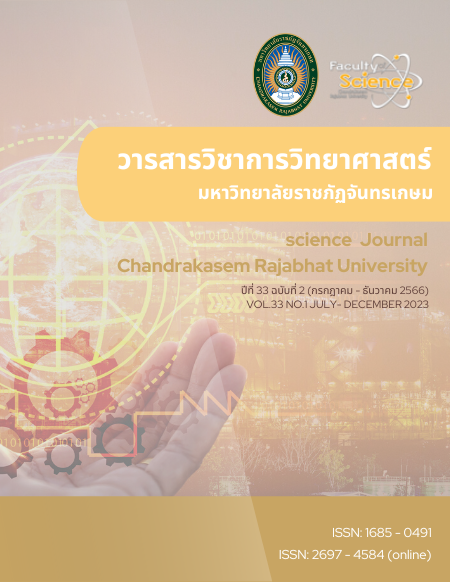ฤทธิ์ต้านเซลล์มะเร็งผิวหนังชนิดเมลาโนมาของสารสกัดเส้นใยเห็ดหลินจือเขากวางด้วยเอทานอล
คำสำคัญ:
มะเร็งผิวหนังชนิดเมลาโนมา, เห็ดหลินจือเขากวาง, โปรแกรมการตายของเซลล์, การแสดงออกของยีนบทคัดย่อ
มะเร็งผิวหนังประเภทเมลาโนมา เป็นมะเร็งที่พบว่ามีอุบัติการณ์สูงมากขึ้นทุกปี มีความรุนแรงและเป็นสาเหตุการตายถึงร้อยละ 75 ของผู้ป่วยโรคมะเร็งผิวหนังทั้งหมด ทั้งนี้แนวทางรักษาปัจจุบัน เช่น การผ่าตัด ยาเคมีบำบัดและรังสีรักษาส่งผลข้างเคียงกับผู้ป่วย ดังนั้นการศึกษาเพื่อพัฒนาแนวทางการรักษาแบบใหม่จึงมีความจำเป็น จากรายงานพบว่าสารสกัดจากดอกเห็ดหลินจือเขากวางมีฤทธิ์ต้านมะเร็งชนิดต่าง ๆ แต่ยังไม่มีการรายงานฤทธิ์ต้านมะเร็งผิวหนังประเภทเมลาโนมา ในงานวิจัยชิ้นนี้จึงมีจุดประสงค์ในการศึกษาฤทธิ์ต้านเซลล์มะเร็งผิวหนังชนิดเมลาโนมา (A375) ของสารสกัดเส้นใยเห็ดหลินจือเขากวางด้วยเอทานอล ผลการศึกษาความเป็นพิษด้วยเทคนิค MTT พบว่าความเข้มข้นที่สูงขึ้นของสารสกัดเส้นใยเห็ดหลินจือเขากวางแปรผันตรงกับความเป็นพิษต่อเซลล์มะเร็ง A375 แต่มีความเป็นพิษที่ต่ำมากในเซลล์ปกติ (Vero) สำหรับผลการศึกษาการติดฉลากเซลล์ด้วย Annexin V พบว่าที่ความเข้มข้น 250 ไมโครกรัมต่อไมโครลิตรของสารสกัดเห็ดสามารถเหนี่ยวนำโปรแกรมการตายของเซลล์มะเร็ง A375 ได้ในระดับอ่อน และผลการศึกษาด้วยเทคนิคปฏิกิริยาลูกโซ่พอลีเมอเรสแบบเวลาจริง พบว่าความเข้มข้น 250 ไมโครกรัมต่อไมโครลิตรของสารสกัดเห็ดสามารถลดการแสดงออกของยีน signal transducer and activator of transcription 1 (ยีน STAT1) ซึ่งเป็นยีนเครื่องหมายของโรคมะเร็งผิวหนังประเภทเมลาโนมาถึง 5 เท่า แต่ไม่มีผลต่อยีน 2'-5'- oligoadenylate synthetase 1 (ยีน OAS1) ในเซลล์มะเร็ง A375 ดังนั้นผลการทดลองนี้เป็นการนำเสนอองค์ความรู้ใหม่ บ่งชี้ให้เห็นว่าสารสกัดเส้นใยเห็ดหลินจือเขากวางมีศักยภาพในการศึกษาในเชิงลึกต่อไป
เอกสารอ้างอิง
Abubakar, A. R., & Haque, M. (2020). Preparation of Medicinal Plants: Basic Extraction and Fractionation Procedures for Experimental Purposes. J Pharm Bioallied Sci, 12(1), 1-10.
Bellettini, M. B., Fiorda, F. A., Maieves, H. A., Teixeira, G. L., Ávila, S., Hornung, P. S., Júnior, A. M., & Ribani, R. H. (2019). Factors affecting mushroom Pleurotus spp. Saudi J Biol Sci, 26(4), 633-646.
Berger, R. G., Bordewick, S., Krahe, N. K., & Ersoy, F. (2022). Mycelium vs. Fruiting Bodies of Edible Fungi-A Comparison of Metabolites. Microorganisms, 10(7).
D’Orazio, J., Jarrett, S., Amaro-Ortiz, A., & Scott, T. (2013). UV radiation and the skin. International journal of molecular sciences, 14(6), 12222-12248.
de Mendonça, D. E. A., de Godoy, M. A. F., Lucredi, N. C., Comar, J. F., Almeida, I. V., & Vicentini, V. E. P. (2023). Toxicogenic effects of the mushroom Ganoderma lucidum on human liver and kidney tumor cells and peripheral blood lymphocytes. Journal of Ethnopharmacology, 307, 116226.
Hong, K. J., Dunn, D. M., Shen, C. L., & Pence, B. C. (2004). Effects of Ganoderma lucidum on apoptotic and anti-inflammatory function in HT-29 human colonic carcinoma cells. Phytother Res, 18(9), 768-770.
Hu, Y., Ahmed, S., Li, J., Luo, B., Gao, Z., Zhang, Q., Li, X., & Hu, X. (2017). Improved ganoderic acids production in Ganoderma lucidum by wood decaying components. Sci Rep, 7, 46623.
Huang, L., Chen, J., Zhao, Y., Gu, L., Shao, X., Li, J., Xu, Y., Liu, Z., & Xu, Q. (2019). Key candidate genes of STAT1 and CXCL10 in melanoma identified by integrated bioinformatical analysis. IUBMB life, 71(10), 1634-1644.
Huang, Y. Z., Zheng, Y. X., Zhou, Y., Xu, F., Cui, Y. Z., Chen, X. Y., Wang, Z. Y., Yan, B. X., Zheng, M., & Man, X. Y. (2022). OAS1, OAS2, and OAS3 Contribute to Epidermal Keratinocyte Proliferation by Regulating Cell Cycle and Augmenting IFN-1‒Induced Jak1‒Signal Transducer and Activator of Transcription 1 Phosphorylation in Psoriasis. J Invest Dermatol, 142(10), 2635-2645.e2639.
Kohguchi, M., Kunikata, T., Watanabe, H., Kudo, N., Shibuya, T., Ishihara, T., Iwaki, K., Ikeda, M., Fukuda, S., & Kurimoto, M. (2004). Immuno-potentiating effects of the antler-shaped fruiting body of Ganoderma lucidum (Rokkaku-Reishi). Bioscience, biotechnology, and biochemistry, 68(4), 881-887.
Lim, W. Z., Cheng, P. G., Abdulrahman, A. Y., & Teoh, T. C. (2020). The identification of active compounds in Ganoderma lucidum var. antler extract inhibiting dengue virus serine protease and its computational studies. Journal of Biomolecular Structure and Dynamics, 38(14), 4273-4288.
Liu, W., Yuan, R., Hou, A., Tan, S., Liu, X., Tan, P., Huang, X., & Wang, J. (2020). Ganoderma triterpenoids attenuate tumour angiogenesis in lung cancer tumour-bearing nude mice. Pharmaceutical Biology, 58(1), 1070-1077.
Mau, J. L., Lin, H. C., & Chen, C. C. (2001). Non-volatile components of several medicinal mushrooms. Food Research International, 34, 521-526.
Nonaka, Y., Shibata, H., NakaI, M., Kurihara, H., Ishibashi, H., Kiso, Y., Tanaka, T., Yamaguchi, H., & Abe, S. (2006). Anti-tumor activities of the antlered form of Ganoderma lucidum in allogeneic and syngeneic tumor-bearing mice. Bioscience, biotechnology, and biochemistry, 70(9), 2028-2034.
Patel, S., & Goyal, A. (2012). Recent developments in mushrooms as anti-cancer therapeutics: a review. 3 Biotech, 2, 1-15.
Pfeffer, C. M., & Singh, A. T. (2018). Apoptosis: a target for anticancer therapy. International journal of molecular sciences, 19(2), 448.
Sajadimajd, S., Bahramsoltani, R., Iranpanah, A., Patra, J. K., Das, G., Gouda, S., Rahimi, R., Rezaeiamiri, E., Cao, H., & Giampieri, F. (2020). Advances on natural polyphenols as anticancer agents for skin cancer. Pharmacological research, 151, 104584.
Schwartz, S. L., Park, E. N., Vachon, V. K., Danzy, S., Lowen, A. C., & Conn, G. L. (2020). Human OAS1 activation is highly dependent on both RNA sequence and context of activating RNA motifs. Nucleic Acids Research, 48(13), 7520-7531.
Simoes, M. F., Sousa, J. S., & Pais, A. C. (2015). Skin cancer and new treatment perspectives: A review. Cancer letters, 357(1), 8-42.
Stephanou, A., & Latchman, D. S. (2003). STAT‐1: a novel regulator of apoptosis. International journal of experimental pathology, 84(6), 239-244.
Sudheer, S., Taha, Z., Manickam, S., Ali, A., & Cheng, P. G. (2018). Development of antler-type fruiting bodies of Ganoderma lucidum and determination of its biochemical properties. Fungal biology, 122(5), 293-301.
Tang, W., Liu, J. W., Zhao, W. M., Wei, D. Z., & Zhong, J. J. (2006). Ganoderic acid T from Ganoderma lucidum mycelia induces mitochondria mediated apoptosis in lung cancer cells. Life Sci, 80(3), 205-211.
Thongthae, N., Payungporn, S., Poovorawan, Y., & T-Thienprasert, N. P. (2014). A rational study for identification of highly effective siRNAs against hepatitis B virus. Experimental and Molecular Pathology, 97(1), 120-127.
Waiyaput, W., Payungporn, S., Issara-Amphorn, J., & Panjaworayan, N. T. (2012). Inhibitory effects of crude extracts from some edible Thai plants against replication of hepatitis B virus and human liver cancer cells. BMC Complement Altern Med, 12, 246.
WHO. (2020). Skin Cancer. International Agency for Research on Cancer. Retrieved 19 March 2023 from https://www.iarc.who.int/cancer-type/skin-cancer/
Wu, L., Dong, B., Zhang, F., Li, Y., & Liu, L. (2016). Prediction of the engendering mechanism and specific genes of primary melanoma by bioinformatics analysis. Dermatologica sinica, 34(1), 14-19.
Zhang, Y., & Liu, Z. (2017). STAT1 in cancer: friend or foe? Discovery medicine, 24(130), 19-29.
Zheng, L., Wong, Y. S., Shao, M., Huang, S., Wang, F., & Chen, J. (2018). Apoptosis induced by 9, 11‑dehydroergosterol peroxide from Ganoderma Lucidum mycelium in human malignant melanoma cells is Mcl‑1 dependent. Molecular Medicine Reports, 18(1), 938-944.

ดาวน์โหลด
เผยแพร่แล้ว
รูปแบบการอ้างอิง
ฉบับ
ประเภทบทความ
สัญญาอนุญาต
ลิขสิทธิ์ (c) 2023 มหาวิทยาลัยราชภัฏจันทรเกษม

อนุญาตภายใต้เงื่อนไข Creative Commons Attribution-NonCommercial-NoDerivatives 4.0 International License.
บทความที่ได้รับการตีพิมพ์เป็นลิขสิทธิ์ของมหาวิทยาลัยราชภัฏจันทรเกษม
ข้อความที่ปรากฎในบทความแต่ละเรื่องในวารสารวิชาการเล่มนี้เป็นความคิดเห็นส่วนตัวของผู้เขียนแต่ละท่าน ไม่เกี่ยวข้องกับมหาวิทยาลัยราชภัฏจันทรเกษม และคณาจารย์ท่านอื่นในมหาวิทยาลัยแต่อย่างใด ความรับผิดชอบองค์ประกอบทั้งหมดของบทความแต่ละเรื่องเป็นของผู้เขียนแต่ละท่าน หากมีความผิดพลาดใดๆ ผู้เขียนแต่ละท่านจะรับผิดชอบบทความของตัวเองแต่เพียงผู้เดียว

 สำหรับผู้แต่ง (Author)
สำหรับผู้แต่ง (Author)





